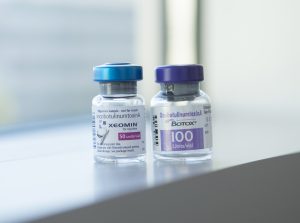
Botox
Botulinum toxin calms muscles restoring natural body position
The mainstay of treatment of dystonia is with injection of botulinum toxin, such as Botox or Xeomin.
Botulinum toxin injections (Botox) work by causing a disruption between the nerve and the muscle, thereby weakening the muscle into which it is injected.
Conditions treated with botulinum toxin injection:
- Blepharospasm and hemifacial spasm: facial muscles are injected to reduce involuntary blinking or grimacing movements.
- Spasticity due to stroke or multiple sclerosis or other conditions: upper or lower limb muscles are injected to relax abnormal muscle posture and stiffness.
- Migraine: muscles of the face and neck are injected to reduce muscle tension that contributes to headache. There may also be a reduction in the release of substance P, which contributes to the pain pathway.
- Sialorrhea (drooling due to Parkinson’s disease): salivary glands are injected to reduce release of saliva.
- Cervical dystonia: muscles that are pulling or twisting the neck to one side are overactive, Botox works to calm those specific muscles down and allows for a more natural and neutral head position.

Depending on the muscle injected, EMG guidance may be used during Botox injection to verify muscle activity and ensure the most active part of the muscle is being injected.
The number of units and injections varies depending on the procedure. The entire procedure takes about 20-30 minutes in the clinic. Botox takes about 3-7 days after injection to show activity, and the duration of effect lasts about 10-14 weeks. Most patients return every 12 weeks for repeat injection. Side effects of facial injections include eyelid droop, weakness of eyelid closure, eyebrow droop, dry eye, double vision, and facial droop. Side effects typically occur due to spread of the toxin to other muscles, and may include neck weakness, trouble holding the head up, neck pain, swallowing difficulty, and rarely slurred speech. All side effects resolve after several weeks.
In some patients, botulinum toxin injections are not sufficient to control the symptoms, and oral medications may be useful as additional treatment. These include benzodiazepines such as clonazepam, anticholinergics such as trihexiphenidyl, and muscle relaxants such as baclofen. All of these medications can be associated with muscle weakness, somnolence (sleepiness), dizziness, imbalance, and fogginess. In addition, trihexiphenidyl can cause dry mouth, nausea, constipation, urinary retention (inability to urinate) and confusion. Therefore, these oral medications are not considered first line over botulinum toxin injection.
